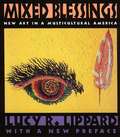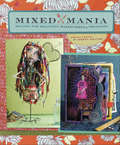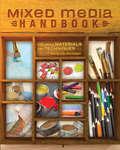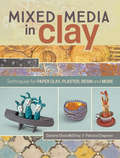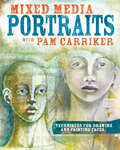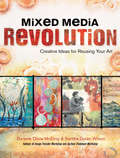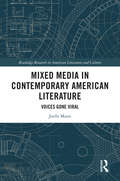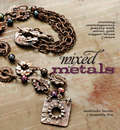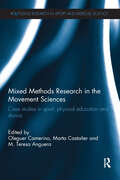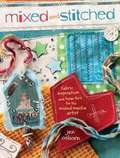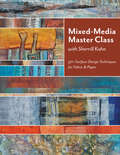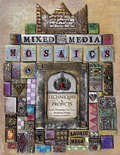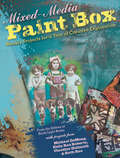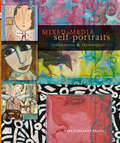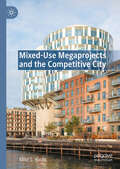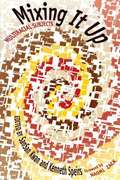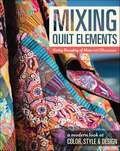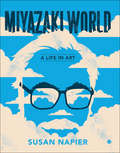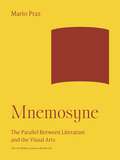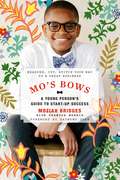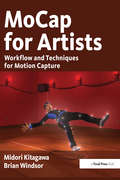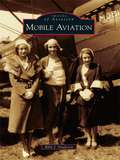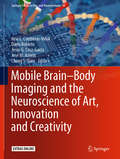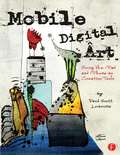- Table View
- List View
Mixed Blessings: New Art in a Multicultural America
by Lucy R. LippardThe New Press is proud to publish a new paperback edition of Mixed Blessings, the first book to discuss the cross-cultural process taking place in the work of contemporary Latino, Native, African, and Asian American artists. Rich with illustrations of artworks in many different media, and filled with incisive quotes and unsettling reports, it is more than a book about art; it is a complex meditation on the relationships of people to their cultures. Lucy R. Lippard, one of our most original and insightful writers on art, challenges conventional approaches and explores the role of images in a changing society. Among her subjects are the uncertainty of exile; the confusion of identity in attempts to climb out of the melting pot; and art that speaks for itself, reversing stereotypes and reclaiming history and memory. The New Press edition features a new introduction by Lippard that reconsiders the issues first presented in Mixed Blessings when it appeared in 1990 and evaluates the state of multicultural art today.
Mixed Mania: Recipes for Delicious Mixed Media Creations
by Cheryl Prater Debbie CraneFrequent Cloth Paper Scissors contributors Debbi Crane and Cheryl Prater have whipped up this book featuring 20-plus smart and sassy projects divided like a cookbook into appetizers, main courses, and sweet treats for a fresh perspective on creating mixed-media projects. From artist books to assemblage, art quilts to art dolls, it's all here, plus how-to instructions on a variety of mixed-media, collage, and surface design techniques.Step-by-step projects are laid out like recipes complete with ingredients (materials), instructions (what to mix, add), and tips (how it should look, taste, etc.), showcasing colorful, innovative projects created with a variety of ephemera and mixed-media materials. Techniques for making art quilts, collages, assemblages, memory art, bookbinding, doll making, and paper crafting are included. An inspiring gallery of work by popular artists is also included.
Mixed Media Handbook: Exploring Materials and Techniques
by Kimberly SantiagoMake the most of the time, money and heart you invest in your art. Successful mixed-media art starts with selecting the best materials and tools for the job. Here's where the very thing that attracts many artists to the genre--the vast array of available supplies and media--can also pose the greatest challenge: How to choose from the wide variety of options for any given project? Mixed Media Handbook makes your decisions easier and more confident by providing a complete and current working guide to today's traditional and unconventional materials, including tools; substrates; adhesives & mediums; paper, photographs & other collage resources,; natural materials, building supplies & household items; drawing materials, and painting media. Selecting an appropriate surface for rubber-stamping, the best adhesive for attaching beads, or the right medium for a desired effect involves more than reading a few specifications on a data sheet. That's why each alphabetical entry includes notes on best practices for application, archival quality or longevity and ideas for using the materials in your art. In addition, 18 step-by-step demonstrations illustrate techniques such as creating a painted map substrate, turning a slide into a collage element, and using encaustics. No matter what your skill level, having this information at your fingertips will save you time and money, encourage greater experimentation in your art and free you up to focus on the fun part--creating.
Mixed Media In Clay: Techniques for Paper Clay, Plaster, Resin and More
by Darlene Olivia Mcelroy Pat ChapmanWhat can you do with clay? Anything you want.For all that you can make with it, clay is an artist's dream--the perfect way to add more "mix" to your mixed-media art. But if the baking and firing it usually requires aren't your thing, you've come to the right book! In Mixed Media in Clay you'll use this traditional medium in excitingly different ways (no oven or kiln needed), and we'll also explore a wide array of alternative clays and clay-like options (resin, plastic, paper mache, plaster and more, even homemade recipes) and the many surprising ways you can use them. Create jewelry beads or a large sculpture. Produce a print or a textural background for a painting. Cast a replica or a replacement part. Create art big and small. There's no limit what you can do with clay and its creative cousins! Darlene Olivia McElroy and Pat Chapman expertly guide the way with plenty of inspiration, ideas, techniques and troubleshooting tips.Inside you will find:19 chapters covering printing, casting, molding, armatures, sculpting, pouring, dipping and more12 types of clay and alternatives (including resin clay, paper mache, plaster, fiber paste and Critter Clay, powdered clay and more) plus recipes for six make-at-home clay mediumsMore than 130 techniques, more than 40 tips and countless project ideasAccess to exclusive online content--4 full step-by step projects and even more tips and techniquesSo, what are you waiting for? Let your clay-play adventures begin!
Mixed Media Portraits with Pam Carriker: Techniques for Drawing and Painting Faces
by Pam CarrikerSet your portraits apart from the rest!Portraits can be an intimidating subject. But not with Art At the Speed of Life author and workshop instructor Pam Carriker as your teacher. She helps you take on faces one quick sketch at a time for faster, easier, more enjoyable drawing and painting. Not your average book on drawing the face, Mixed Media Portraits With Pam Carriker shows easy ways to draw more realistic faces in your own signature style. The goal is not an immaculate finished portrait, but a continually growing collection of personal, expressive sketches that you can use and reuse in your mixed-media work.Inside you'll find:An easy-to-learn face-mapping technique that allows you to draw faces from your imagination, without a model or photo in front of youMini-demonstrations breaking down each facial featureSimple color combinations for mixing both realistic and out-of-the-ordinary skin tones15 step-by-step projects featuring original ways to use your portraits as starting points for mixed-media masterpiecesTons of expert tips, from selecting the right pencil for the job to creating self-portraits, working with reference photos and using transfer techniques In the true spirit of mixed media, this book is all about combining, layering and experimenting in your pursuit of portrait nirvana. It will get you out of your comfort zone and into the habit of making faces that are truly and uniquely your own.
Mixed Media Revolution: Creative Ideas for Reusing Your Art
by Darlene Olivia Mcelroy Sandra Duran WilsonRecycle, Reuse, Reinvent! With Mixed Media Revolution, you'll learn how to leverage your art and take your paintings and transfers to the next level! Leftovers, little bits and scraps, pieces of art that didn't turn out quite right...we all have them. And it hurts to have to throw them away. But what if someone could suggest another way? Another way, perhaps, to get one more use out of that transparency. Or cut up a piece of art and put it back together differently. Or use leftover paint to create one-of-a-kind transfers? Darlene Olivia McElroy and Sandra Duran Wilson, in their groundbreaking third book, will show you how to do all those things and more! Inside You'll Find: 10 themed chapters More than 50 fully stepped-out, photographic mixed media techniques More than 80 additional fast and easy techniques Dozens of troubleshooting tips and variations More than 70 big, beautiful finished pieces of art illustrating the techniques Links to online bonus content You'll find something new and exciting on every page--add Mixed Media Revolution to your creative toolbox and expand your artistic horizons today!
Mixed Media in Contemporary American Literature: Voices Gone Viral (Routledge Research in American Literature and Culture)
by Joelle MannMixed Media in Contemporary American Literature: Voices Gone Viral investigates the formation and formulation of the contemporary novel through a historical analysis of voice studies and media studies. After situating research through voices of nineteenth- and twentieth-century American literature, this book examines the expressions of a multi-media vocality, examining the interactions among cultural polemics, aesthetic forms, and changing media in the twenty-first century. The novel studies shown here trace the ways in which the viral aesthetics of the contemporary novel move language out of context, recontextualizing human testimony by galvanizing mixed media forms that shape contemporary literature in our age of networks. Through readings of American authors such as Claudia Rankine, David Foster Wallace, Jennifer Egan, Junot Díaz, Michael Chabon, Joseph O’Neill, Michael Cunningham, and Colum McCann, the book considers how voice acts as a site where identities combine, conform, and are questioned relationally. By listening to and tracing the spoken and unspoken voices of the novel, the author identifies a politics of listening and speaking in our mediated, informational society.
Mixed Metals: Creating Contemporary Jewelry with Silver, Gold, Copper, Brass, and More
by Danielle FoxUtilizing stringing and wireworking techniques accessible to beginners, this mixed metal jewelry guide also offers boutique-style designs that will captivate the more experienced beader. With no metalworking required, detailed instructions are provided for 30 unique projects incorporating various metals such as silver, gold, copper, brass, PMC, and more. Techniques for distressing metal - such as using liver of sulfur, other patinas, and hammering - are included, as well as ideas for mixing metals and using faux metals. Background information is given on each type of metal, from common properties to shopping tips, care, and cleaning.
Mixed Methods Research in the Movement Sciences: Case Studies in Sport, Physical Education and Dance (Routledge Research in Sport and Exercise Science)
by Oleguer Camerino Marta Castañer M. Teresa AngueraMixed methods research techniques, combining both quantitative and qualitative elements, have become well established throughout the social, behavioural and natural sciences. This is the first book to focus on the application of mixed methods research in the movement sciences, specifically in sport, physical education and dance. Researchers and practitioners in each of these fields are concerned with the study of habitual behaviour in naturalistic contexts, and of the concurrent and sequential nature of events and states, precisely the kind of work that multi-method research design can help illuminate. The book is arranged into four sections. The first provides a thorough overview of mixed methods procedures and research design, and summarizes their applicability to the movement sciences. The remaining sections then offer detailed case studies of mixed methods research in team and individual sports (analyzing hidden patterns of play and optimising technique); kinesics and dance (analyzing motor skills behaviour in childhood, and the complexity of motor responses in dance); and physical education (detecting interaction patterns in group situations, and optimizing non-verbal communication by teachers and sports coaches). Mixed Methods Research in the Movement Sciences offers an important new tool for researchers and helps to close the gap between the analysis of expert performance and our understanding of the general principles of movement science. It is important reading for any student, researcher or professional with an interest in motor control, sport and dance pedagogy, coaching, performance analysis or decision-making in sport.
Mixed Race Hollywood
by Camilla Fojas Mary BeltranA Kansas City Star 2008 Notable BookSince the early days of Hollywood film, portrayals of interracial romance and of individuals of mixed racial and ethnic heritage have served to highlight and challenge fault lines within Hollywood and the nation’s racial categories and borders. Mixed Race Hollywood is a pioneering compilation of essays on mixed-race romance, individuals, families, and stars in U.S. film and media culture.Situated at the cutting-edge juncture of ethnic studies and media studies, this collection addresses early mixed-race film characters, Blaxploitation, mixed race in children’s television programming, and the "outing" of mixed-race stars on the Internet, among other issues and contemporary trends in mixed-race representation. The contributors explore this history and current trends from a wide range of disciplinary perspectives in order to better understand the evolving conception of race and ethnicity in contemporary culture.
Mixed and Stitched
by Jen Osbornpaint and markers, fabric and thread?IT?S TIME TO MIX THINGS UP! Whether you're a mixed-media artist or a passionate sewer, discover innovative ways to combine fabrics, textures, found objects and more to create meaningful pieces of fabric art. In addition to inspiring mixed-media techniques, insideMixed and Stitched you'll find: Step-by-step instructions for 16 personal projects such as journals, love notes, bags and home d cor items. Free-form, ?sketchy? stitching techniques that put the stress of sewing perfection to rest. Techniques for dyeing your own fabric to achieve custom colors for any project! Original ?bonus? embroidery designs to enhance the projects or spice up your own fabric creations. A gallery of mixed-media and fabric art to help inspire your own works of imagination. Unleash your inner ?stitch artist? and getMixed and Stitchedtoday!
Mixed-Media Master Class with Sherrill Kahn: 50+ Surface-Design Techniques for Fabric & Paper
by Sherrill Kahn“[Add] color and texture to quilts, art pieces, and just about any fabric or paper surface . . . a colorful and fun addition to any crafts collection.” —California Bookwatch Create along with mixed-media master Sherrill Kahn as she shows you dozens of ways to make luminous textures and surfaces on both paper and fabric. This step-by-step visual guide demonstrates exactly how to get great results using paints, inks, resists, stamps, markers, and much more. Add color and texture to collages, art quilts, or just about any creative project by exploring more than 50 fun and inventive techniques using easy-to-find supplies.“With step-by-step visuals, Sherrill shows you ways to make luminous textures and surfaces on both paper and fabric using easy-to-find supplies. You’ll be a mixed media master in no time!” —Quilter’s Digest“This is a good reference book to go back to time and again. Also very useful for beginning art quilters and mixed media artists.” —Down Under Textiles Magazine“A book offering just about everything you need to know for surface design. Using everything from coffee filters and sandwich wrap to Lutradur, photo paper, and fabric, as well as an abundance of other supplies, readers are given step-by-step instructions for creating texture, making resists and rubbings, silkscreening, printmaking, and much more.” —Cloth Paper Scissors
Mixed-Media Mosaics: Techniques and Projects Using Polymer Clay Tiles, Beads and Other Embellishments
by Laurie MikaImagine beautiful mosaic pieces with tiles that you easily create yourself! Mixed-Media Mosaicsoffers a fresh, new approach to a traditional art form. By making your own tiles from polymer clay, you control the size, shape, color and even the texture, resulting in beautiful finished pieces that include tabletops, boxes, jewelry and shrines. In addition to learning traditional tiling techniques such as working with grout and cutting glass tile, you'll also explore creative options for personalizing tiles: Discover the magic of mica powders and the regal look they can give to mosaics Learn quick and easy ways of adding paint to handcrafted and commercial tile See how easy it is to create molds and cast your own relief tiles Find ways to add personal meaning to your work with the addition of text tiles Experiment with the addition of beads, jewelry and other embellishments by embedding them right into the tile! Whether you'd like to complete a mosaic tabletop for your patio, a jewelry box as a special gift, or simply experiment with jewelry, you'll find the inspiration you seek inMixed-Media Mosaics. Start creating your custom mosaic pieces today.
Mixed-Media Paint Box: Weekly Projects for a Year of Creative Expression
by Editors of North Light BooksPlay With Paint All Year Long! Incorporating paint into your mixed-media art has never been easier or more fun. Open up your paint box and delve into a year of creative ideas from 45 of your favorite artists. Whether you've used paint for years or have been anxious to try a new medium, you'll find great advice and ideas inside Mixed-Media Paint Box. Each week, you'll be guided with step-by-step instructions through a different project or technique that will add instant depth and drama to your art! Inside you'll find: 52 projects and techniques, one for every week of the year, to inspire a weekly dose of creativity. Tips, hints and suggestions from some of your favorite authors, including Ruth Rae, Claudine Hellmuth, Chrissie Grace, Bernie Berlin and Margot Potter. Step-by-step instructions for jewelry-making, assemblage, journaling, collage and a variety of painting techniques to incorporate into your own art. Discover inspiration and new ways to express yourself every week inside Mixed-Media Paint Box!
Mixed-Media Self Portraits: Inspiration and Techniques
by Cate Coulacos PratoFeaturing artwork from a wide range of contributors, this resource explores creative self-portraits through fun and easy exercises and essays that instruct and inspire artists working in all media. Examples of collage, fiber arts, and mixed-media artwork offer visual inspiration while essays throughout the book act as a guide to personal and artistic self-discovery. Step-by-step techniques and creative prompts are used to direct artists through different approaches to creating self-portraits while exercises utilizing collage, drawing, photography, and stitching will jump-start the creative process and get ideas flowing on paper and fabric, encouraging artists to express themselves in new ways.
Mixed-Use Megaprojects and the Competitive City
by Mike S. HarrisThis book examines the motives and outcomes of competitively positioned mixed-use megaprojects on government-owned land. These projects have emerged worldwide in recent decades, driven by urban international competition, the mobility and expansion of knowledge economies, the shift of global investment from physical to human capital, and the prevalence of market-driven or entrepreneurial politics. Six case studies across three countries are analysed through five themes: Positioning, Governing, Shaping, Connecting, and Public Benefit. While pursuing similar objectives of attracting mobile capital, each project operates within a specific political, financial and social context. These projects reflect the prevailing development practices and underlying power structures of cities and states. Throughout the implementation process, they can also reveal the power struggles and competing agendas within a city. In this manner, they serve as a valuable lens for understanding the political, economic, and cultural dynamics of a city, and how urban morphology manifests these processes.
Mixing It Up: Multiracial Subjects
by Sansan Kwan Kenneth SpeirsThe United States Census 2000 presents a twenty-first century America in which mixed-race marriages, cross-race adoption, and multiracial families in general are challenging the ethnic definitions by which the nation has historically categorized its population. Addressing a wide spectrum of questions raised by this rich new cultural landscape, Mixing It Up brings together the observations of ten noted voices who have experienced multiracialism first-hand.<P><P>From Naomi Zack's "American Mixed Race: The United States 2000 Census and Related Issues" to Cathy Irwin and Sean Metzger's "Keeping Up Appearances: Ethnic Alien-Nation in Female Solo Performance," this diverse collection spans the realities of multiculturalism in compelling new analysis. Arguing that society's discomfort with multiracialism has been institutionalized throughout history, whether through the "one drop" rule or media depictions, SanSan Kwan and Kenneth Speirs reflect on the means by which the monoracial lens is slowly being replaced.
Mixing Quilt Elements: A Modern Look at Color, Style & Design
by Kathy DoughtyPush yourself to new realms of quiltmaking Discover your boundless potential as a quilter with Kathy Doughty of Material Obsession. Learn to express yourself with creative, adventurous designs, all made achievable through step-by-step instructions. Shake up your approach with techniques you might not have tried, like English paper piecing, raw-edge machine appliqué, and improvisational piecing. With each chapter, Kathy gives a glimpse into her eclectic fabric pairings and signature style, empowering you to develop your own voice as a quilter. • Master the art of mixing fabrics with Kathy Doughty of Material Obsession! Go behind the scenes of her eclectic, signature style • Break out of your comfort zone! Step-by-step guide to English paper piecing, appliqué two ways, using wedge rulers, and improvisational piecing • Embrace your design sensibilities and develop your own voice • Learn to express yourself through creative, adventurous designs with Kathy’s expert guidance
Miyazakiworld: A Life in Art
by Susan NapierThe story of filmmaker Hayao Miyazaki's life and work, including his significant impact on Japan and the world A thirtieth†‘century toxic jungle, a bathhouse for tired gods, a red†‘haired fish girl, and a furry woodland spirit—what do these have in common? They all spring from the mind of Hayao Miyazaki, one of the greatest living animators, known worldwide for films such as My Neighbor Totoro, Princess Mononoke, Spirited Away, Howl’s Moving Castle, and The Wind Rises. Japanese culture and animation scholar Susan Napier explores the life and art of this extraordinary Japanese filmmaker to provide a definitive account of his oeuvre. Napier insightfully illuminates the multiple themes crisscrossing his work, from empowered women to environmental nightmares to utopian dreams, creating an unforgettable portrait of a man whose art challenged Hollywood dominance and ushered in a new chapter of global popular culture.
Mnemosyne: The Parallel Between Literature and the Visual Arts (The A. W. Mellon Lectures in the Fine Arts #16)
by Mario PrazThe classic study of the timeless relationship between literature and the visual artsIn his search for a common link between literature and the visual arts, Mario Praz draws on the abundant evidence of mutual understanding and correspondence they have long shared. Praz explains that within literature, each epoch has “its peculiar handwriting or handwritings, which, if one could interpret them, would reveal a character, even a physical appearance,” and while these characteristics belong to the general style of a given period, the personality of the writer does not fail to pierce through. Praz contends that something similar occurs in art. He shows how the likeness between the arts within various periods of history can ultimately be traced to structural similarities that arise out of the characteristic way in which the people of a certain epoch see and memorize facts aesthetically. Mnemosyne, at once the goddess of memory and the mother of the muses, presides over this view of the arts. In illustrating her influence, Praz ranges widely through Western sources, providing an incomparable tour of the literary and pictorial arts.
Mo's Bows: Measure, Cut, Stitch Your Way to a Great Business
by Moziah Bridges Tramica MorrisA Young Person's Guide to Starting Your Own Business Written by a Successful Kidpreneur! Running a successful business can be hard for anyone, but seventeen-year-old Moziah Bridges has becomes a pro at it. His company, Mo's Bow's, is what today's "kidpreneurs" dream of achieving--a successful business selling a product that one loves and is passionate about. Mo shares with young business-minded readers his BOWS of Business: Believe in yourself, take the Opportunity to give back, Work hard/study hard, and have Support from friends and family. He knows there is a Mo's Bows in every household-kids just need someone to help nurture their talents.Aimed at young middle grade readers, Mo's Bows: A Young Person's Guide to Startup Success follows Mo's journey to success and reveals all the ups and downs and important lessons he's learned along the way-as well as provides information and tips on how to start your own business and succeed. Complete with a foreword by New York Times bestselling author Daymond John, this book is sure to inspire budding young entrepreneurs to achieve their business goals.
MoCap for Artists: Workflow and Techniques for Motion Capture
by Midori Kitagawa Brian WindsorMake motion capture part of your graphics and effects arsenal. This introduction to motion capture principles and techniques delivers a working understanding of today's state-of-the-art systems and workflows without the arcane pseudocodes and equations. Learn about the alternative systems, how they have evolved, and how they are typically used, as well as tried-and-true workflows that you can put to work for optimal effect. Demo files and tutorials provided on the downloadable resources deliver first-hand experience with some of the core processes.
Mobile Aviation (Images of Aviation)
by Billy J. SingletonLocal businessman and inventor John Ellis Fowler introduced the concept of the flying machine to Mobile and South Alabama. Fowler's innovative designs mark the beginning of the remarkable aviation heritage of Alabama's port city, a legacy further enhanced by the evolution of military and civilian aviation on Alabama's Gulf Coast. A mild climate and abundance of flat terrain made the region attractive for the establishment of military flight training programs during the World War II while the availability of air, rail, and sea transportation made Mobile an ideal location for construction of a supply and repair depot to support military aviation in the Southeast. Images of Aviation: Mobile Aviation is the story of the first century of powered flight in Mobile and South Alabama.
Mobile Brain-Body Imaging and the Neuroscience of Art, Innovation and Creativity (Springer Series on Bio- and Neurosystems #10)
by Jose L. Contreras-Vidal Chang S. Nam Dario Robleto Jesus G. Cruz-Garza José M. AzorínMobile Brain–Body Imaging and the Neuroscience of Art, Innovation and Creativity is a trans-disciplinary, collective, multimedia collaboration that critically uncovers the challenges and opportunities for transformational and innovative research and performance at the nexus of art, science and engineering. This book addresses a set of universal and timeless questions with a profound impact on the human condition: How do the creative arts and aesthetic experiences engage the brain and mind and promote innovation?How do arts–science collaborations employ aesthetics as a means of problem-solving and thereby create meaning?How can the creative arts and neuroscience advance understanding of individuality and social cognition, improve health and promote life-long learning?How are neurotechnologies changing science and artistic expression?How are the arts and citizen science innovating neuroscience studies, informal learning and outreach in the public sphere?Emerging from the 2016 and 2017 International Conferences on Mobile Brain–Body Imaging and the Neuroscience of Art, Innovation and Creativity held in Cancun, Mexico and Valencia, Spain to explore these topics, this book intertwines disciplines and investigates not only their individual products—art and data—but also something more substantive and unique; the international pool of contributors reveals something larger about humanity by revealing the state of the art in collaboration between arts and sciences and providing an investigational roadmap projected from recent advances.Mobile Brain–Body Imaging and the Neuroscience of Art, Innovation and Creativity is written for academic researchers, professionals working in industrial and clinical centers, independent researchers and artists from the performing arts, and other readers interested in understanding emergent innovations at the nexus of art, science, engineering, medicine and the humanities. The book contains language, design features (illustrations, diagrams) to develop a conversational bridge between the disciplines involved supplemented by access to video, artistic presentations and the results of a hackathon from the MoBI conferences.
Mobile Digital Art: Using the iPad and iPhone as Creative Tools
by David Scott LeibowitzLearn how to create beautiful artwork on your iPad or iPhone. Over 65 expert artists from around the world will show you how they created their original art, from inspiration and conceptualization, to the creation of the final image. Using step-by-step examples and easy-to-follow tutorials, you'll learn how to create stunning images on your iPad or iPhone. Learn more about using the apps you already have, like Brushes, and discover new apps that will enhance your art creation like Sketchbook Mobile, Layers, Collage, Juxtaposer, Hiptamatic, and PhotoFX. Whether you are taking you first steps into digital art, or are an accomplished artist looking to broaden your skill set, Mobile Digital Art covers it all - how to turn photographs into oil paintings, design cartoons from scratch and create beautiful landscape vistas - all on your iPad or iPhone.
